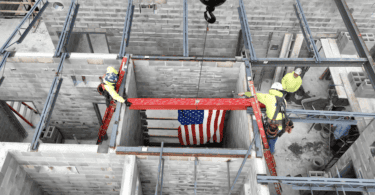by Marc Perras and Ethan Biederman
We recently experienced the benefits of mass timber with the C. Gerald Lucey building, a 33,000 GSF, $28.1 million office for the Commonwealth’s Department of Employment Assistance in Brockton, completed this fall. There were challenges, as there would be with any “new” material – mostly in the realm of procurement/logistics. But we are firmly in the camp of the converted. Here’s why:
Reduced Carbon Footprint
The environmental benefits of mass timber buildings show up in major ways, both reducing carbon emissions and increasing carbon sequestration – about 360 metric tons of carbon benefit on this project.
The carbon storage benefit of mass timber hinges on using ethically sourced wood. The wood for the Lucey Building was sourced from forests certified by the Programme for the Endorsement of Forest Certification (PEFC – an international designation) and the Forestry Stewardship Council (FSC). Both certifications are issued after an audit by an accredited independent body and are based on environmental, societal and economic respect. The entire supply chain must be certified to guarantee an eco-responsible product.
Savings, Speed and Safety
CLT serves as both structural and finish material. Although it must be protected during construction, there is substantial savings in using exposed timber structure and slabs as finish material.
Timber and CLT erection time is substantially faster than a steel and composite deck – for the Lucey project it was half the time of the steel, cutting the schedule by more than a month. The bigger the project the greater the time savings. Plus, once installed a CLT deck acts as an immediate worksurface/barrier to work below, reducing construction pauses and increasing safety – unlike a corrugated steel deck, which can be quite dangerous when left exposed with sheer studs and hangers (especially in winter); meanwhile, no welding means work below can proceed smoothly.
Aesthetics and Wellness
Because CLT and glulam beams can double as finish materials, occupants experience the visual and visceral warmth of wood, which is proven to lead to fewer sick days and greater employee retention. There is some concern for acoustics in a timber structure, primarily footfall noise. In the Lucey building, public spaces were designed with built-up acoustic floors to prevent noise below. Sound baffles hung from the wood deck reduce noise over meeting areas, and a sound masking system is scattered throughout the call center to ensure conversations remain private.
Living Wage Jobs
In September, The U.S. Economic Development Administration awarded the Oregon Mass Timber Coalition $41 million to develop Oregon’s emerging mass timber industry, including funds for research, a factory, forest restoration, and building code modernization. As mass timber gains traction in the Northeast, there is the potential to create new jobs in forestry, construction and manufacturing. New England currently has no CLT mills, but it could. A 2017 analysis concluded that local CLT production could be competitive in the Northeast market (Pöyry Management Consulting/New England Forestry Foundation).
Replicable, Marketable
We hope this project is a source of inspiration for owners, developers and their design teams. As most of us in the AEC sector know, buildings (operation) and their construction account for 38% of all energy-related CO2 emissions (UN 2020 Global Status Report for Building and Construction). Direct building CO2 emissions need to halve by 2030 to get on track for net zero carbon building stock by 2050, a critical target for keeping the global temperature rise below 1.5°C. Mass timber can help us get there.
The Lucey building shows not just how state-funded projects can be delivered with cost-effective, sustainable design, but the promise of how many “ordinary” commercial projects in our region, i.e., mid-rise, infill buildings designed for various uses, could take advantage of mass timber’s many benefits, including getting us closer to that increasingly urgent goal.
Marc Perras, AIA, is associate principal at Jones Architecture, and Ethan Biederman focuses on pre-construction at South County Post & Beam.















